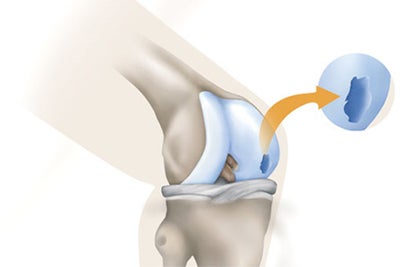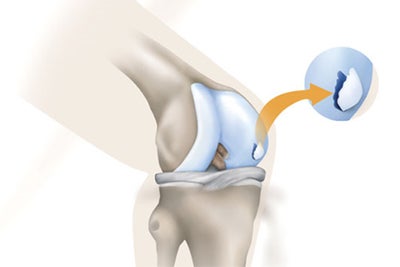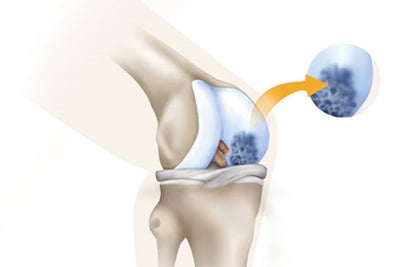About Knee Cartilage
Your knee is under a lot of pressure, so it’s no wonder that just one false move can result in injury to the ligaments and cartilage in the joint. Cartilage is the surface on the ends of the bones in your knee that allow the joint’s surfaces to glide friction-free. Symptoms of knee cartilage injuries include pain, swelling, popping in the joint and locking of the joint. Daily activities such as sitting down, standing up, or walking up stairs may become difficult. Fortunately, there are a variety of treatment options available to help alleviate your symptoms.
Causes of Cartilage Injuries
Knee cartilage may be injured through activity, trauma, or a disease such as osteochondritis dessicans that affects the bone beneath the cartilage and causes the overlaying cartilage to “blister.” These types of injuries are called focal defects because they usually affect a portion of the cartilage in that joint.
Types of Knee Cartilage Injuries
These injuries are caused by short, intensive, non-physiological strain on the joint and as a result, pieces of cartilage become detached from the joint surface. The depth of these lesions can vary, and not everyone affected complains of pain, although the cartilage is already damaged. This condition often affects young, active people who can subject their joints to non-physiological strain either during sport or in normal daily activity.
Osteochondritis Dessicans is the name of a bone disease that occurs most frequently in youths and young adults. When individual areas of the bone are affected, the cartilage covering these areas can also become diseased. This results in the affected section of cartilage becoming detached and forming a free body within the joint, leaving a lesion that reaches down into the bone. Left untreated, this may lead to longer term degenerative cartilage defects. These defects differ from focal defects in that they usually affect all of the cartilage in the joint.
Osteoarthritis is a degenerative cartilage defect that develops from wear and tear of the cartilage surface as part of the aging process. The cartilage surface gradually becomes rough and is then slowly worn away over a long period of time, until finally bone is rubbing against bone. At this point, the treatment usually involves replacing the joint with an artificial knee. Discover more information about knee replacement.
Why Cartilage Doesn’t Heal Itself
If you cut your finger, the wound heals within a few days or weeks as the skin can regenerate itself. It is different in the case of cartilage. The hyaline cartilage in a healthy knee joint is the most common type of cartilage in the body and is specially designed for absorbing shock and providing a friction-free surface. It is a tissue which contains a small number of cartilage cells (chondrocytes) by volume. These are responsible for the formation of cartilage tissue. As in contrast to many other tissues in the body, cartilage is not supplied by blood vessels or nerves, which means that following an injury or disease-related changes, it only has a small capacity to heal itself. In the long term, the resulting repair tissue cannot withstand the stress placed on it as it does not possess the low-friction surface, and impact and pressure absorption of healthy joint cartilage. Even though cartilage may be unable to heal quickly and may have long lasting damage, there are many forms of treatment available for cartilage regeneration and symptom relief.



